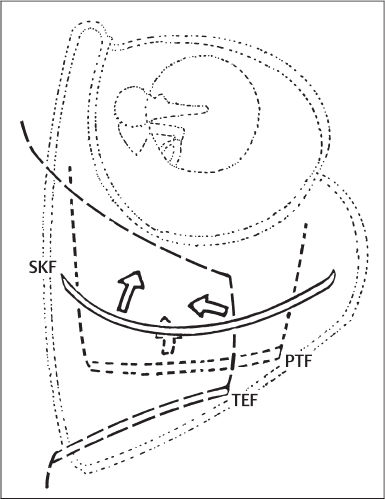32 Minimally Invasive Cochlear Implantation with Mastoidal Three-layer Flap Minimally invasive cochlear implantation with mastoidal three-layer flap. SKF: Skin flap, TEF: Temporomastoidal flap, PTF: Palva-type flap Execution of a minimally invasive cochlear implantation procedure with a three-layer flap (TLF) approach, which is based on using the superficial musculoaponeurotic system (SMAS) as an additional, strong flap layer. The three-layer flaps, with three different pedicles, are: an anteriorly based 4cm skin flap; a superiorly based temporomastoidal flap, which includes SMAS; and an anteriorly based periosteal Palva-type flap in the same mastoid area. The minimally invasive TLF technique is used in cochlear implantation. A small 4cm retroauricular incision, with a slight anterior curve, is made 1.5cm posterior to the postauricular crease. Only limited subcutaneous dissection, 1.5cm anteriorly and 1.5cm posteriorly, is carried out with a No.20 blade. This maneuver exposes the mastoid soft tissues, which include the SMAS and periosteum. The next step is elevation of the temporomastoidal flap. Using the same No.20 blade, a 2cm long vertical incision is first made along the anterior limit of the mastoid. Next, a second 2cm long vertical incision is made along the posterior limit of the mastoid, and a third 2–3cm long horizontal incision is made close to the mastoid tip, connecting the vertical incisions. Then, working superficially, the thin flap is elevated. At the temporal line, the plane of dissection is changed to the subperiosteal level by cutting all the soft tissues including the periosteum. Therefore, a superiorly based temporomastoidal flap is formed, which includes the mastoidal SMAS inferiorly and the temporoparietal fascia, temporal fascia, temporal muscle, and temporal periosteum superiorly. The next step of the technique is elevating a thin, anteriorly based Palva-type flap, which consists solely of periosteum of the mastoid. In this way, three flaps with three different pedicles have been developed in the same mastoid area. Although the flaps forming the second and third layers are thin, they are very strong because of the tissue nature of the SMAS and periosteum. The mastoidectomy, posterior tympanotomy, cochleostomy or round window exploration, and implant placement steps of the approach are the same as in classical cochlear implantation. However, closure and fixation differ from the classical cochlear implantation operation. First, the Palva-type periosteal flap is sutured to the periosteum close to the mastoidooccipital junction. Second, the temporomastoidal flap is replaced into its original position and sutured to the soft tissues on the mastoid tip and to the inferior part of the Palva-type flap. This closure enables full coverage of the receiver-stimulator and mastoidectomy area, as well as fixing the receiver-stimulator firmly in place. No additional means of fixation are required. The wound incision is closed with a few subcutaneous and cutaneous sutures. Definitions and Tips

Definition
Indications
Surgical Technique
Minimally Invasive Cochlear Implantation with Mastoidal Three-layer Flap
Only gold members can continue reading. Log In or Register to continue

Full access? Get Clinical Tree


